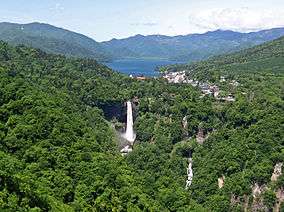Kegon Falls
| Kegon Falls 華厳滝 - Kegon Taki | |
|---|---|
 Kegon Falls and Lake Chūzenji | |
| Location | Nikkō National Park, Tochigi Prefecture, Honshū, Japan |
| Coordinates | 36°44′17″N 139°30′09″E / 36.73806°N 139.50250°ECoordinates: 36°44′17″N 139°30′09″E / 36.73806°N 139.50250°E |
| Type | Plunge |
| Total height | 97 metres (318 ft) |
| Number of drops | 1 |
| Total width | 7 metres (23 ft) |
| Watercourse | Oshiri River |
Kegon Falls (華厳滝 Kegon Taki) is located at Lake Chūzenji (source of the Oshiri River) in Nikkō National Park near the city of Nikkō, Tochigi Prefecture, Japan. The falls were formed when the Daiya River was rerouted by lava flows. The main falls had a height of approximately 97 metres (318 ft) and about twelve smaller waterfalls are situated behind and to the sides of Kegon Falls, leaking through the many cracks between the mountain and the lava flows.
In the autumn, the traffic on the road from Nikko to Chūzenji can sometimes slow to a crawl as visitors come to see the fall colors.
In 1927, the Kegon Falls was recognized as one of the "Eight Views" which best showed Japan and its culture in the Shōwa period.[1] It is also listed as one of the "Japan’s Top 100 Waterfalls", in a listing published by the Japanese Ministry of the Environment in 1990.
The Kegon Falls are infamous for suicides, especially among Japanese youth.[2]
Suicides
Misao Fujimura (1886 – May 22, 1903), a Japanese philosophy student and poet, is largely remembered due to his farewell poem written directly on the trunk of a tree before committing suicide by jumping from the Kegon Falls.
The story was soon sensationalized in contemporary newspapers and was commented upon by the famed writer Natsume Sōseki. This led the famed scenic falls to become a notorious spot for lovetorn or otherwise desperate youngsters to take their lives (Werther Effect).[3]
| Wikimedia Commons has media related to Kegon Falls. |
References
- ↑ 日本八景(昭和2年)の選定内容. Ministry of the Environment of Japan. Retrieved on March 3, 2012. (Japanese)
- ↑ "Lake Chūzenji". Encyclopædia Britannica. 2011. Retrieved October 13, 2011.
- ↑ Iga, Mamoru (1978). "Suicide in Japan". Social Science & Medicine. Part A: Medical Psychology & Medical Sociology. 12 (4): 513. doi:10.1016/0271-7123(78)90118-9. PMID 734468. p. 519
External links
- A trip to Kegon Falls with fall colours
- A short video taken from the bottom of Kegon Falls
- Tourism website for Kegon Falls (Japanese)